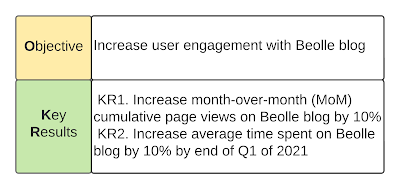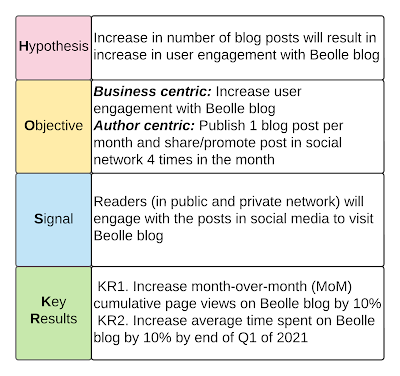 |
As a business analyst and product manager we often use various frameworks to synthesize and organize our product ideas and goals. I think of frameworks as tools in our product management tool kit which we use depending on the task at hand.
And speaking of goals, OKR is a very popular framework that I often use to set the goals for the products I am managing. However recently I participated the #ProductCon conference hosted by Product School and I stumbled upon one of the talks in which Rapha Cohen, the CPO at Google Waze introduced a more effective framework for setting product goals. The framework is called HOSKR.
In this post I'll describe both the OKR and HOSKR frameworks in more details using examples. I hope this will provide you, our readers, more practical insights on how to effectively use these frameworks to set your product goals.
OKR
OKR stands for Objectives and Key Results. If you are reading this post then you are on our Beolle blog and I am going to use one of the OKRs of our Beolle blog to explain the framework.
An example of an OKR for the Beolle blog is outlined below:
HOSKR
HOSKR stands for the following:
Hypothesis
Objective
Signal
Key Results
According to Rapha before a product manager can apply HOSKR he/she must develop a qualitative worldview in which the product resides. For example, for the Beolle blog this worldview will look something like the following:
In this example I chose to represent the worldview as a funnel however the worldview can be represented using any of the business analysis techniques including context diagrams as applicable. The worldview can also be represented using a combination of techniques if required.
Once the worldview is established then the hypothesis can be framed and the objective, signal and key results defined.
An example of an HOSKR for Beolle blog is outlined below:
As you can see in the example HOSKR allows us, product managers to synthesize more details for our product goals. HOSKR also provides us a framework to find the link between the objective and the key results - the signal. One of the key guidelines for applying HOSKR is to continuously take the key findings post execution to better frame the worldview. This ensure that the worldview better reflects the reality in which the product resides at a given time.
In conclusion I think both OKR and HOSKR are very useful frameworks for setting product goals and have an important place in a product manager's tool kit. While OKR allows us to quickly synthesize our product goals HOSKR allows us to define our product goals with more granularity. Hence I highly encourage my bellow product managers to use these frameworks to set more effective product goals.
Credits, references and collaborations
- Photo by Berk Ozdemir from Pexels







